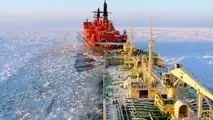US in a gas war with Iran, Russia, own allies
The United States is flaunting its emerging energy prowess as a potential weapon as it draws a new line in the sand for global domination.
On Thursday, Russian President Vladimir Putin signed off on a new state policy strategy that views the US as aspiring to dominate the world’s oceans. The strategy pins down the potential areas of conflict, citing the Arctic where the US and its allies are striving “to reach an intimidating supremacy.”
The issue of geopolitical rush for Arctic resources has been dominating debate in international relations for some time, with the five littoral states – Russia, the US, Canada, Norway and Denmark/Greenland – jockeying for position for its oil and gas interests.
Putin’s strategy outline, binding until 2030, reiterates the Arctic and the globe’s resource-rich northernmost a priority development area for Russia in the face of the four other countries, all of whom are US allies.
The document states that the US and its allies are trying to “limit Russia’s access to resources at sea and its access to vitally important naval transport communications.”
'Great tool' to undermine foes
The claim is not without ground. US military analyst James “Spider” Marks who has led many business ventures since retirement from the Army where he spent over 30 years and attained the rank of major general sums up America’s possible designs for supremacy, including for countering Russia and its allies.
“If the United States is to counter the global influence of Russia, Iran, China and other hostile nations, we will need to find peaceful ways to advance our interests while undermining theirs,” he wrote on the website of Washington-based Morning Consult company.
Marks singled out natural gas as “a great tool to use for this purpose,” keeping in mind that Russia is the No. 2 producer of the fuel in the world, followed by Iran, and China as No. 6.
Global demand is rising across the world for natural gas which is viewed the big fuel of the next two decades. Gas consumption is on track to hit almost 4,000 billion cubic meters by 2022 and China is projected to account for almost 40 percent of growth.
Shale revolution
US advances in directional drilling and hydraulic fracturing has made the United States the world’s No. 1 producer of natural gas. America’s ability to extract energy from vast shale formations has put the country on the brink of being a global energy powerhouse.
President Donald Trump's refusal earlier this month to sign up to the communique pledging to implement the Paris climate accord has added new momentum to America's fracking activities. The Energy Department said on Monday that US shale production was set to rise for the eighth consecutive month in August.
“First, as we produce more of our own gas, we reduce our dependence on foreign sources of energy. Second, as our production grows, so does our ability to advance our interests abroad through exports,” Marks wrote.
“This provides America unprecedented global flexibility, to engage internationally at a time and place of our choosing,” he added.
Exerting power over allies
Marks identifies the target areas which Washington can use its natural gas a double-edged weapon - exerting power over allies and countering enemies. He cites three Middle Eastern countries — Iran, Qatar and Saudi Arabia — which hold 40 percent of the world’s natural gas reserves, with Iran projected to have the largest growth in natural gas production through 2040.
“Although the United States might not become an exporter to these countries, it can pump its own gas into the world market, keeping prices down and reducing reliance on the Middle East’s dominant producers.”
According to the International Energy Agency (IEA), the United States will challenge Qatar and Australia as the highest exporters by 2022 with more than half of the natural gas produced to be converted to liquefied natural gas (LNG) for export.
Three major LNG terminals are currently under construction in the US, which will double the number of US ports in use. The number of LNG consuming countries is expected to rise to 39 countries this year, making them amenable for fresh inroads and influence.
Rising liquefaction capacity is coming into a market already saturated, and the glut is driving down prices at the expense of traditional suppliers such as Qatar and Saudi Arabia, underlining their current diplomatic crisis.
US shale oil is already weighing down on the country’s allies in the Persian Gulf, especially Saudi Arabia whose joint efforts with Russia to prop up prices have not produced intended results.
According to a UK-based consultancy, Riyadh which is hardly pressed for oil revenues because of its war in Yemen and other expenses is now considering unilaterally cutting its oil exports by 1 million barrels a day (bpd).
Targeting Russia and China
The next targets are Russia as the world’s second gas producer and China as the sixth, both trying to increase their market share.
“By maximizing its natural gas production and getting this gas to market efficiently and reliably, the United States can accomplish two goals. It can reduce its dependence on foreign energy while increasing its influence in global affairs at the expense of Russia and China,” Marks noted.
“If we add to the global supply by increasing our exports, we further weaken Russia and China while strengthening our own alliances,” he added.



